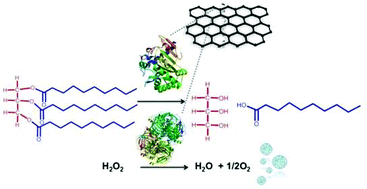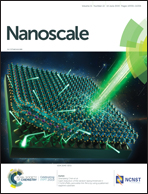Thiographene synthesized from fluorographene via xanthogenate with immobilized enzymes for environmental remediation†
Abstract
Graphene, graphene oxide and their related thiographene-, hydroxygraphene- or fluorographene-based materials have broad applications. We report on the thiol-functionalization of fluorographene via xanthogenate. Such thiographene contains 5.1 at% of sulphur in the form of thiol groups, which is the highest thiol content reported to date. Such tailored thiographene allows the immobilization of two types of enzymes. Here, we explore the functionalization of highly thiolated graphene with enzymes via physisorption or covalent linkage producing an important heterogeneous biocatalyst platform for wastewater treatment applications. Thiographene modified with a lipase from Mucor miehei can find utilization in lipid-rich wastewater treatment whereas the catalase-modified thiographene is intended for bioremediation applications. Upon increasing concentration of the thiol groups on graphene, protein loading of the catalase was increased by 16% and the ester bond cleavage activity of the thiographene-immobilized lipase was 129% that of the free lipase. We expect that such a highly active heterogeneous thiographene-based biocatalyst will find a use in water remediation applications.

- This article is part of the themed collection: Nanocarbons


 Please wait while we load your content...
Please wait while we load your content...